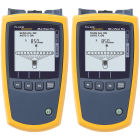How to Increase Multimode Testing Accuracy with Encircled Flux
March 11, 2013 / General, Standard and Certification, Installation and testing
Anyone who’s ever tested a multimode fiber optic link with light sources from different equipment vendors will know that the loss measurement can vary by as much as 50 percent. Without proper controls, multimode light sources will inject light differently into multimode fibers. Even light sources from the same manufacturer operating under different launch conditions, will produce diverse link-loss measurements, leading to different—and often confusing—test results.
Different types of light sources produce different launch conditions. For instance, a light emitting diode (LED) overfills a multimode fiber with too many mode groups while a laser underfills a fiber with not enough mode groups. Overfilling tends to produce link-loss measurements that are inappropriately high and under filling tends to generate loss measurements that are optimistic in regards to the loss that will occur in the cabling once it is operational. .
These skewed results could ultimately hinder the performance of a cabling infrastructure, and that can lead to serious problems in data centers and other environments that rely on optical fiber cabling to link components.
This is all the more troublesome when you consider that as networking technology has evolved and loss budgets have decreased. In order to meet tight loss budgets, testing uncertainty must be minimized. So new, high-bandwidth business applications are the driver for requiring more accurate and reproducible multimode attenuation measurements from field test instruments.
Industry experts have stated that narrowing launch condition variability was needed, particularly when testing for 1 Gigabit or higher over multimode fiber.
So what’s the solution? The answer might lie with a standard called Encircled Flux (EF), a major improvement over previous methods. EF is a method of characterizing the launch conditions of a multimode light source such as an LED or laser. It is the percentage of power within a fiber core radius when light is launched by a optical source into a multimode fiber, and is determined from the near-field measurement of the light coming from the end of a reference-grade test cord attached to the test instrument.
EF compliance can reduce loss measurement variation to +/- 10%. Compared to the preceding standard, which allowed up to 40% variability, EF is a dramatic improvement in multimode testing accuracy and repeatability. For this reason, those who request cable certification, and approve cabling warranties have begun to require compliance with this new standard.
There are currently EF solutions available for field-testing purposes. Called “launch controllers”, they are specially built, test-grade reference cords that are fitted with modal conditioners. The launch controllers work by restricting the number of mode groups launched from the test cord to within EF specifications. This ensures that the resulting measurements are precise and repeatable according to the standards.
Compliance with EF is confirmed by test instrument suppliers using lab equipment designed to make a direct measurement of the power distribution among the different modes contained within a multimode fiber.
The measurement involves analyzing the near-field distribution at the end of the test cord using video and processing methods. The image is then converted to data and a graphical representation. The graph can be plotted within selected EF limits to check for compliance.
The Telecommunications Industry Association (TIA) and International Electrotechnical Commission (IEC) standards bodies both have documents that describe the requirements for EF.
EF is a major improvement in tightening multimode link-loss measurements to within a 10% variability target. It improves on older methods such as modal power distribution and coupled power ratio. Because test instruments meeting the EF standard will provide the most reliable results for certification testing, network engineers and designers need to update their test specifications to require the use of EF-compliant sources.






